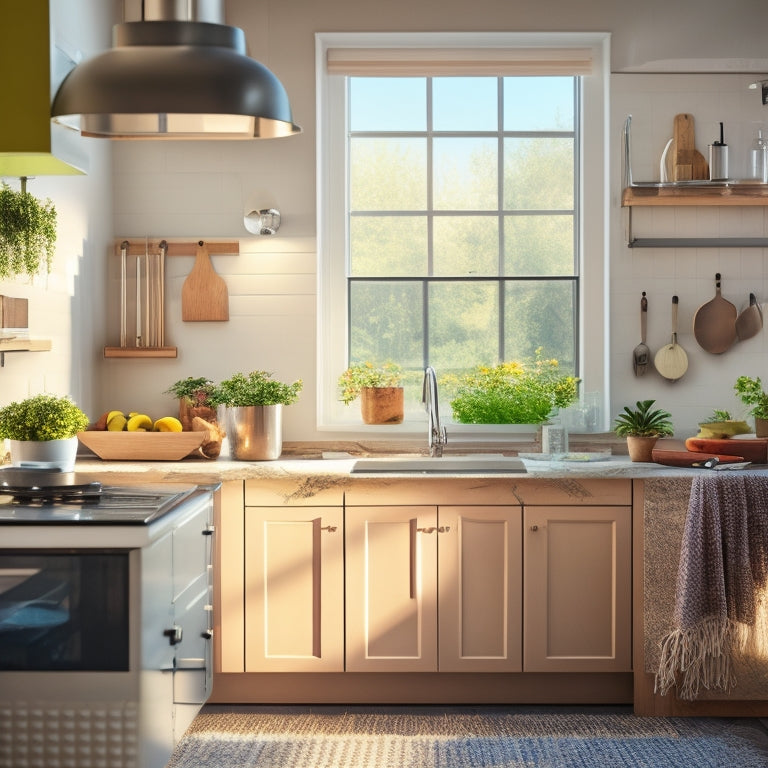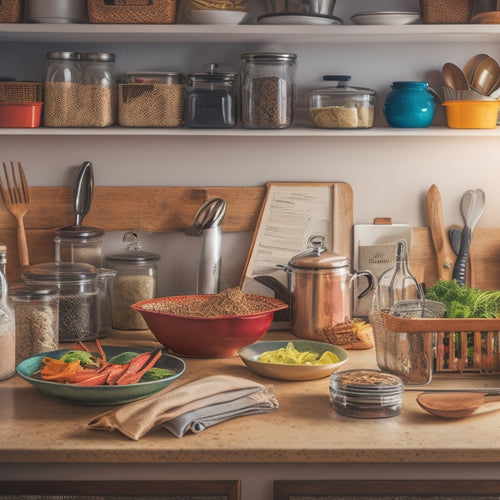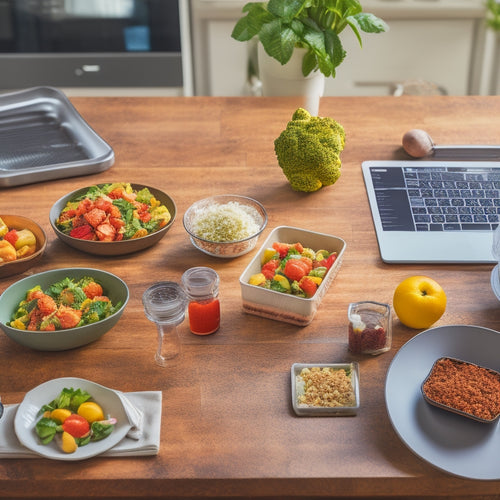
10 Essential Tips for Kitchen Efficiency and Flow
Share
To maximize kitchen efficiency and flow, start by optimizing your layout with a strategic "work triangle" between the sink, stove, and refrigerator. Then, declutter and organize your countertops, assigning a home for each gadget and prioritizing frequently used items. Implement a "clean as you go" policy to avoid messes, and utilize vertical storage opportunities to free up space. Streamline your cooking station workflow by dividing it into prep, cooking, and serving zones. Finally, maintain a consistent cleaning schedule to keep your kitchen running smoothly. By mastering these essential tips, you'll be cooking like a pro in no time - and uncovering even more secrets to a stress-free kitchen awaits.
Key Takeaways
• Create a 'work triangle' between the sink, stove, and refrigerator to optimize kitchen workflow and reduce walking distances.
• Designate specific zones for prep, cooking, and storage to maintain a sense of order and flow in the kitchen.
• Utilize vertical storage opportunities, such as shelves, carousels, and lazy susans, to maximize corner space and free up counter space.
• Prioritize frequently used items and keep them within arm's reach to reduce clutter and increase efficiency.
• Establish a 'Clean as You Go' policy to avoid overwhelming mess and make cleaning a non-negotiable part of cooking.
Optimize Your Kitchen Layout
Optimize Your Kitchen Layout
By rearranging your kitchen layout to create a 'work triangle' between your sink, stove, and refrigerator, you can shave precious minutes off your meal prep time. This kitchen triangle concept is a game-changer for home cooks, as it reduces walking distances and streamlines your workflow.
To maximize efficiency, place your island strategically to avoid disrupting the triangle's flow. A well-placed island can provide additional counter space and storage, but it shouldn't impede your path between the three main stations.
Consider the 'golden zone' of 4-9 feet between each point of the triangle to ensure comfortable movement. Also, think about the 'work zones' within your kitchen, such as a prep area near the sink and a cooking zone near the stove.
Streamline Cooking Station Workflow
Your cooking station workflow can be greatly streamlined by assigning a specific task to each zone, ensuring that every utensil, ingredient, and tool has a designated spot. This will help you stay focused and avoid constant searching for items, allowing you to cook more efficiently.
Consider dividing your cooking station into zones for prep, cooking, and serving. Within each zone, organize your tools and ingredients in a way that makes sense for the task at hand. For example, place your cutting board and knives near the prep zone, and your pots and pans near the cooking zone.
To optimize cooking station ergonomics, position your utensils and ingredients at comfortable heights to reduce strain on your body. Identify workflow bottlenecks, such as congested countertops or hard-to-reach storage, and address them by rearranging your layout or investing in space-saving solutions.
Declutter Countertops and Surfaces
Declutter Countertops and Surfaces
Cluttered countertops and surfaces can slow you down, making it difficult to focus on the task at hand, so clear everything off and sort items into categories to get a sense of what you really need to keep out. This exercise in Countertop Psychology will help you realize what's essential and what's just taking up space.
Be honest with yourself – do you really need that extra coffee maker or can you donate it? By categorizing items, you'll identify patterns and habits that might be contributing to the clutter.
Next, assign a 'zone' for each category, designating a specific area for prep, cooking, and storage. This Surface Sanity approach will help you maintain a sense of order and flow. Remember, the goal is to create a workspace that supports your cooking style, not hinders it.
Assign a Home for Each Gadget
Designate a specific spot for each gadget, ensuring that frequently used items are easily accessible and stored in a logical location. This will help you maintain a clutter-free kitchen and reduce stress while cooking.
Take stock of your gadget inventory and categorize items into groups, such as baking, cooking, and prep tools. Assign a home for each group, considering the frequency of use and the workflow in your kitchen.
Use storage buckets or bins to store smaller gadgets, like spices, oils, or utensils, and label them for easy identification. This will keep countertops clear and make it easier to find what you need when you need it.
Consider installing a pegboard or hooks for hanging items like pots, pans, or utensils, freeing up cabinet space for less frequently used items.
Maximize Storage Space Efficiency
Now that you've assigned a home for each gadget, it's time to make the most of your kitchen's storage space.
You'll be amazed at how much more efficient your kitchen can be when you optimize every nook and cranny.
Optimize Corner Space
By installing a carousel or lazy Susan in your kitchen's corner spaces, you can turn notoriously hard-to-reach areas into easily accessible storage zones. This simple solution allows you to make the most of your kitchen's often-wasted corner space, giving you more room to store essential items.
To further optimize your corner space, consider these ideas:
-
Install corner shelves that can be adjusted to fit different sized items, ensuring you can store everything from large pots to small spices.
-
Use blind cabinets with pull-out shelves or baskets to keep items hidden from view while still being easily accessible.
-
Add a pegboard to the back of a corner cabinet door, providing a convenient spot to hang frequently used utensils and tools.
Utilize Vertical Storage
You can further amplify your kitchen's storage capacity by making the most of your ceiling height and walls, which often remain underutilized. By installing wall shelves and ceiling racks, you can free up valuable floor and counter space, keeping your kitchen clutter-free and organized.
Think vertically when it comes to storing items like pots, pans, utensils, and cookware. Ceiling racks can hold heavy items like infrequently used cookbooks or special occasion dishes, keeping them out of the way but still accessible. Wall shelves can be used to store spices, oils, or other essentials, keeping them within easy reach.
When choosing wall shelves and ceiling racks, consider the weight capacity and durability of the materials. Make sure to install them securely to avoid any accidents or damage.
Purge Unused Items
Cluttered kitchen shelves and drawers hide a dirty little secret: they're often filled with items that haven't seen the light of day in years. It's time to purge those unused items and maximize your storage space efficiency!
You'll be amazed at how liberating it feels to declutter your kitchen. Here are some items you might consider letting go of:
- Appliances you've never used (or haven't used in years)
- Duplicates of items you already have
- Gadgets that seemed like a good idea at the time but never quite lived up to their promise
Don't let emotional attachment hold you back. Remember, these items are taking up valuable space that could be better used for things you actually need and use.
Consider implementing donation strategies, like setting aside a few hours a month to sort through your kitchen items and donate anything that's still in good condition.
Create a Functional Zone System
When designing your kitchen's functional zone system, you'll want to start by identifying the different tasks you perform in the space, such as food prep, cooking, and cleaning.
Next, you'll assign each task to a specific zone, ensuring that the layout flows logically and efficiently.
Zone Designation Strategy
Designate specific zones in your kitchen to streamline tasks and reduce walking distances, making meal prep and cooking more efficient. By creating a functional zone system, you'll be able to focus on specific tasks without having to navigate the entire kitchen. This strategy is all about maximizing your kitchen's potential and minimizing your effort.
Here are some key considerations for your zone designation strategy:
-
Zone Mapping: Identify the most frequently used areas in your kitchen and allocate zones accordingly. This will help you prioritize tasks and optimize your kitchen's layout.
-
Zone Personalization: Tailor each zone to your specific cooking needs and preferences. For example, if you're a baker, you may want to designate a zone for mixing and another for decorating.
-
Task-Oriented Zones: Create zones that cater to specific tasks, such as food prep, cooking, and cleaning. This will help you stay focused and avoid clutter.
Workstation Flow Optimization
Workstation Flow Optimization
By configuring your workstation to flow seamlessly from one task to the next, you'll be able to prep, cook, and serve meals with ease, maximizing your kitchen's efficiency. This is achieved through task segmentation, which involves dividing your workspace into distinct zones, each dedicated to a specific task. This approach enables you to work efficiently, reducing unnecessary movement and increasing productivity.
To create a functional zone system, consider the following principles:
| Zone | Task | Ergonomic Considerations |
|---|---|---|
| Prep Zone | Chopping, slicing, dicing | Height-adjustable countertops, comfortable standing space |
| Cooking Zone | Stovetop, oven, cooking | Easy access to utensils, cookware, and ingredients |
| Serving Zone | Plating, garnishing, serving | Ample counter space, proximity to dining area |
| Cleaning Zone | Washing, drying, sanitizing | Easy access to sink, garbage, and cleaning supplies |
| Storage Zone | Food storage, pantry organization | Optimized shelving, labeling, and accessibility |
Prioritize Frequently Used Items
You'll find that optimizing your kitchen's layout starts with identifying the items you use most often and positioning them in easy-to-reach locations. This simple trick can save you time and energy, allowing you to focus on cooking up a storm.
By prioritizing your daily essentials, you'll eliminate speed bumps that can slow you down. Consider the items you use every day, such as:
- Coffee maker and mugs
- Frequently used spices and oils
- Go-to cooking utensils like tongs and spatulas
Keep these items within arm's reach to minimize walking distances and maximize your workflow. This will give you more time to focus on the fun parts of cooking – experimenting with new recipes, exploring flavors, and enjoying the company of loved ones.
Implement a 'Clean as You Go' Policy
As you chop, dice, and sauté your way through a recipe, make cleaning a concurrent task by wiping down countertops, washing utensils, and putting away ingredients as soon as you're done using them. This 'clean as you go' policy is a game-changer for kitchen efficiency.
By incorporating mindful habits into your daily cooking routine, you'll avoid the overwhelming mess that often comes with meal prep.
Daily discipline is key to maintaining a clutter-free kitchen. Try to make cleaning a non-negotiable part of your cooking process. As you finish using each ingredient, put it away in its designated spot.
Wash and dry utensils immediately after use to prevent clutter from building up. By doing so, you'll free up mental energy and reduce stress in the kitchen.
Adopting this habit will also save you time in the long run. Imagine having a sparkling clean kitchen at the end of each meal, without having to dedicate an extra hour to cleaning up.
Utilize Vertical Storage Opportunities
As you continue to optimize your kitchen's layout, don't forget to look up - and make the most of your kitchen's vertical space. By doing so, you'll be able to free up valuable floor and counter real estate, and create a more streamlined cooking environment.
Now, let's explore three key strategies for maximizing your kitchen's vertical storage potential.
Maximize Corner Space
Your kitchen's often-wasted corner space can be transformed into a valuable storage hub by installing shelves, carousels, or lazy susans that reach up to the ceiling. This won't only maximize your storage capacity but also make the most of the often-hard-to-reach areas.
Here are some ways to make the most of your corner space:
-
Consider installing corner shelves that wrap around the corner, providing easy access to infrequently used items.
-
Blind cabinets can be a great option for corner spaces, as they provide a seamless look while still offering ample storage.
-
Design your corner space with a carousel or lazy susan, allowing you to easily spin and access items in the back without having to dig through everything in front.
Optimize Cabinet Heights
By maximizing your kitchen's vertical space, you can optimize cabinet heights to create a more efficient and organized cooking environment. This is especially crucial for cabinet ergonomics, as it guarantees that you can easily access what you need without straining your back or shoulders.
Here are some tips to help you optimize your cabinet heights:
| Cabinet Height | Optimal Use |
| Top shelves (above 60 inches) | Infrequently used items, such as special occasion dishes or cooking equipment |
| Upper shelves (48-60 inches) | Less frequently used items, such as baking sheets or serving dishes |
| Middle shelves (36-48 inches) | Frequently used items, such as everyday dishes or cooking utensils |
| Lower shelves (24-36 inches) | Heavy or bulky items, such as pots and pans or kitchen appliances |
| Bottom shelves (below 24 inches) | Heavy or large items, such as cookbooks or kitchen gadgets |
Hang Utensil Organizers
To maximize your kitchen's vertical storage space, hang utensil organizers on walls or the back of a door to keep frequently used items within easy reach. This simple trick will free up counter space and streamline your cooking process. By strategically placing utensils, you'll reduce clutter and make meal prep a breeze.
Here are some tips to take into account when hanging utensil organizers:
-
Choose the right materials: Opt for durable, easy-to-clean materials like stainless steel or silicone to make sure your organizer withstands daily use.
-
Take into account utensil placement: Group similar items together, such as all baking utensils or cooking tools, to create a logical workflow.
-
Utilize the back of a door: Take advantage of the often-wasted space on the back of a door or cabinet to hang a utensil organizer, keeping items like spices, oils, or frequently used ingredients within easy reach.
Maintain a Consistent Cleaning Schedule
Establish a daily routine that sets aside a specific time for cleaning and organizing your kitchen, ensuring a consistent pace that keeps your space tidy and functional. You'll be amazed at how a few minutes each day can add up to make a huge difference. Set a timer for 15-20 minutes and tackle one area, like the countertops or sink, to keep clutter at bay.
In addition to your daily routine, schedule seasonal deep cleans to tackle those hard-to-reach areas and appliances that need extra attention. This will prevent the buildup of grime and dust, making your daily cleaning tasks much easier. Create a calendar reminder to dedicate a few hours each quarter to a deeper clean, and you'll be liberated from the stress of a messy kitchen.
Frequently Asked Questions
How Do I Handle Kitchen Utensils With No Designated Storage Space?
"You're drowning in a sea of spatulas and whisks with no storage in sight! Implement Utensil Rotation, where you regularly swap out tools, and get creative with repurposing containers, like mason jars or baskets, to corral the chaos and free up your kitchen space!"
What Is the Ideal Height for Installing Kitchen Shelves and Cabinets?
'When installing kitchen shelves and cabinets, you'll want to take into account the ideal height, ensuring a comfortable reach while maintaining corner clearance. Aim for shelves 12-15 inches deep, allowing easy access to items without cluttering the space.'
Can a Kitchen Island Improve Efficiency, or Is It Just a Trend?
You're wondering if a kitchen island is a game-changer or just a fancy trend? Think of it this way: strategically placing an island can revolutionize your workflow, but only if you've done your workflow analysis and nailed the island placement!
How Often Should I Reorganize My Kitchen Layout to Stay Efficient?
You should reorganize your kitchen layout when you feel stuck, ideally with a Seasonal Refresh or when Lifestyle Changes occur, like moving or having a baby, to make certain your space adapts to your evolving needs.
Are There Any Kitchen Efficiency Apps or Tools That Can Help Me?
You can optimize your kitchen workflow with apps like Plan to Eat, Yummly, or BigOven, which help with meal planning, recipe organization, and grocery lists, freeing you to focus on cooking and enjoying meals.
Related Posts
-

7 Essential Tools to Tame Your Kitchen Chaos
You're one step away from transforming your kitchen into a haven of efficiency and calm. Start by decluttering your c...
-

Budget-Friendly Meal Prep Made Easy With Digital Tools
You're just a few clicks away from effortless meal prep that fits your budget. Digital tools like meal prep planners ...

